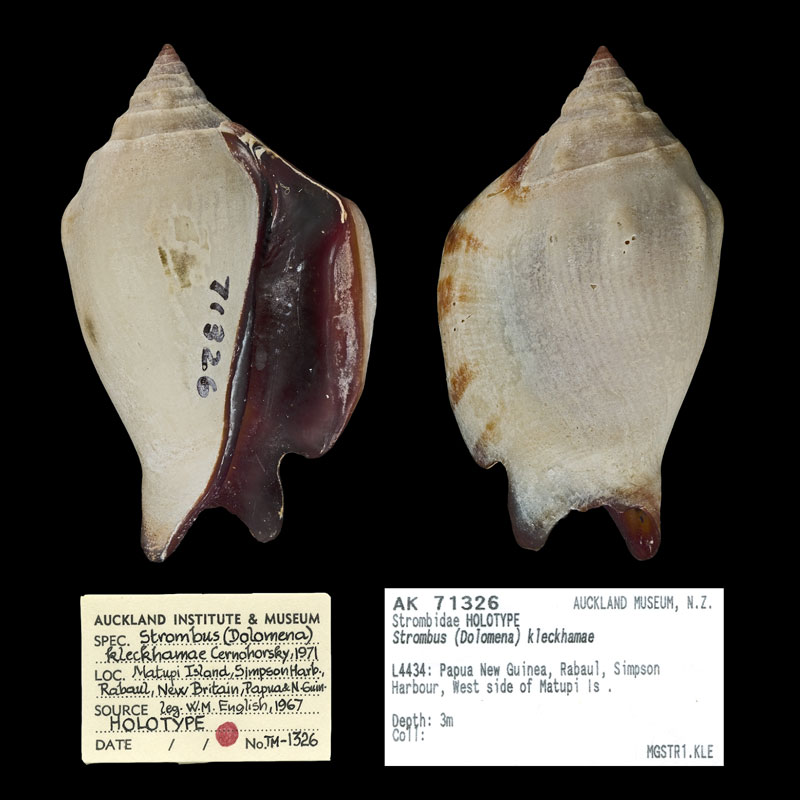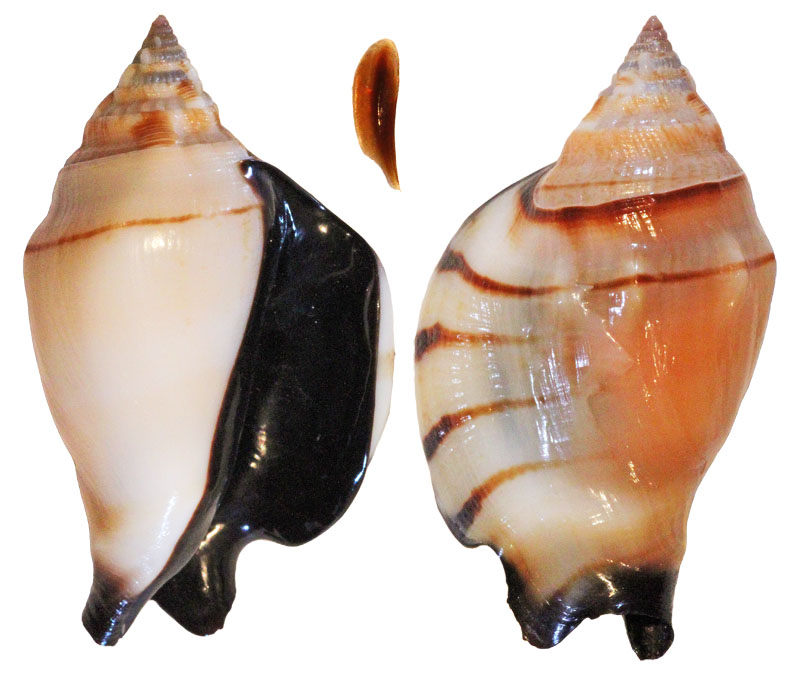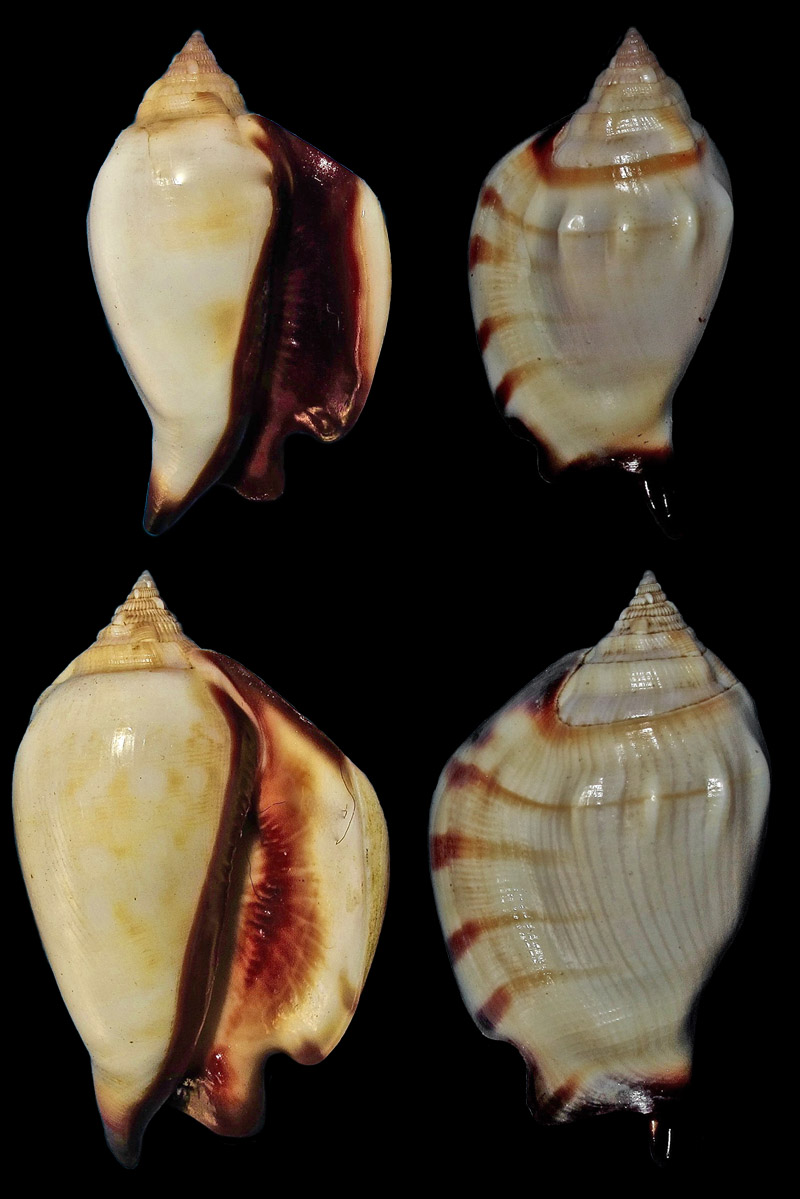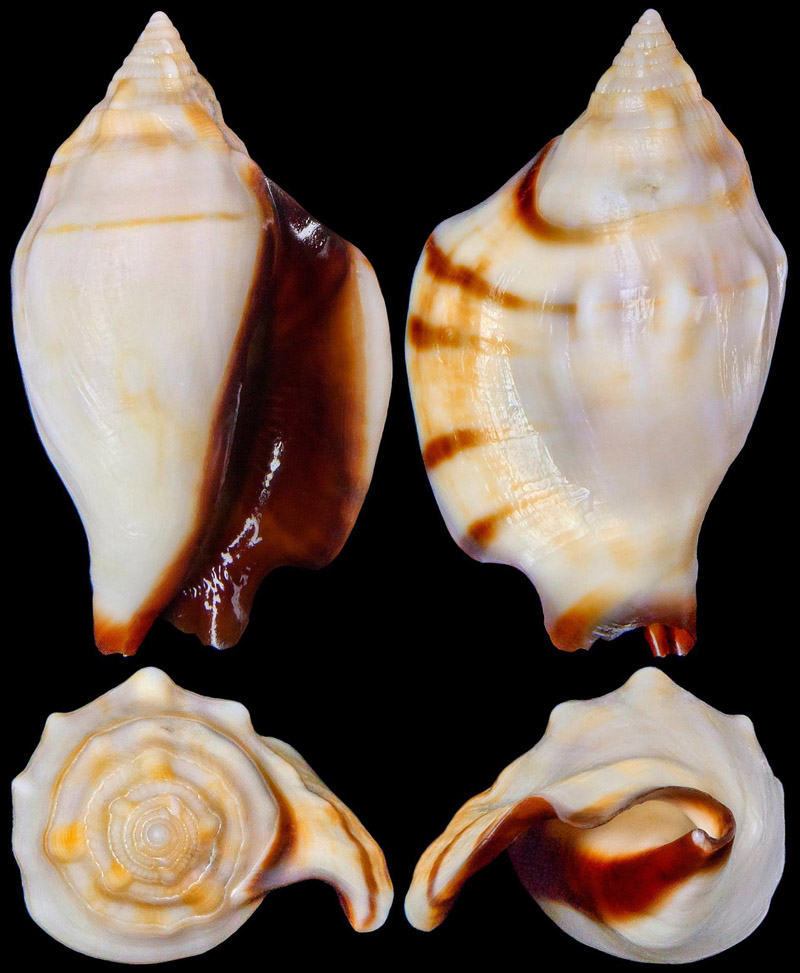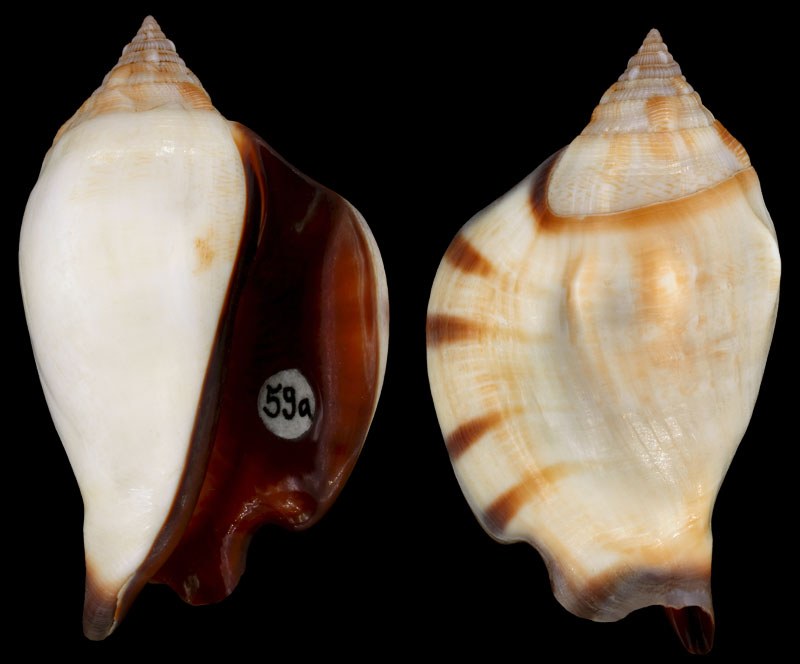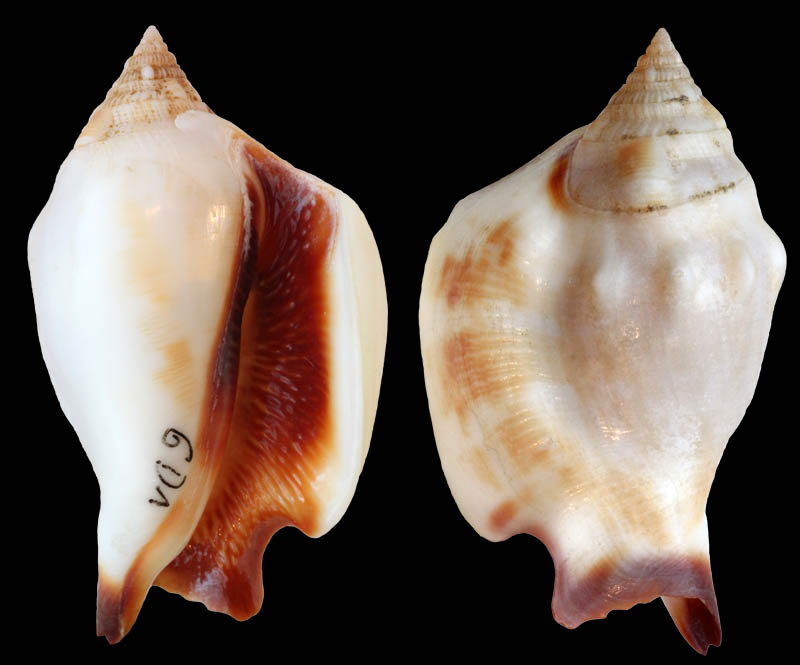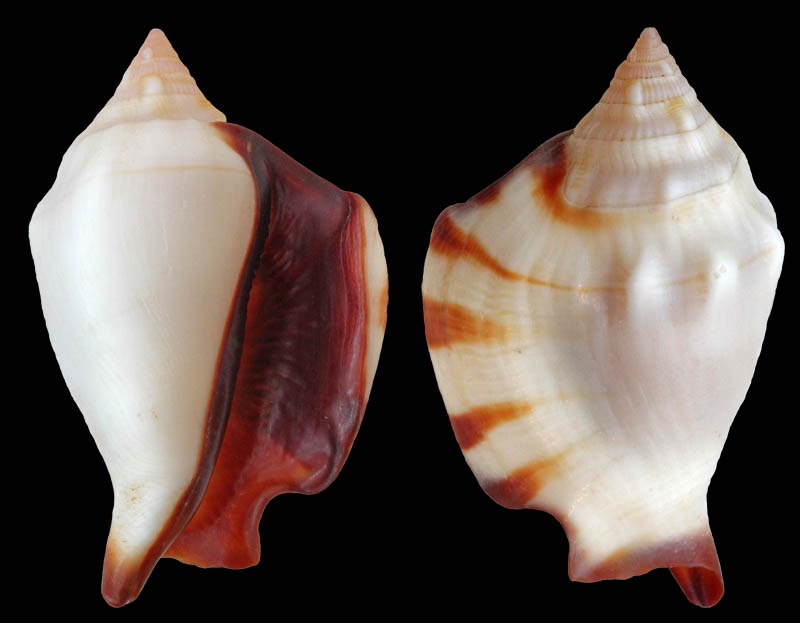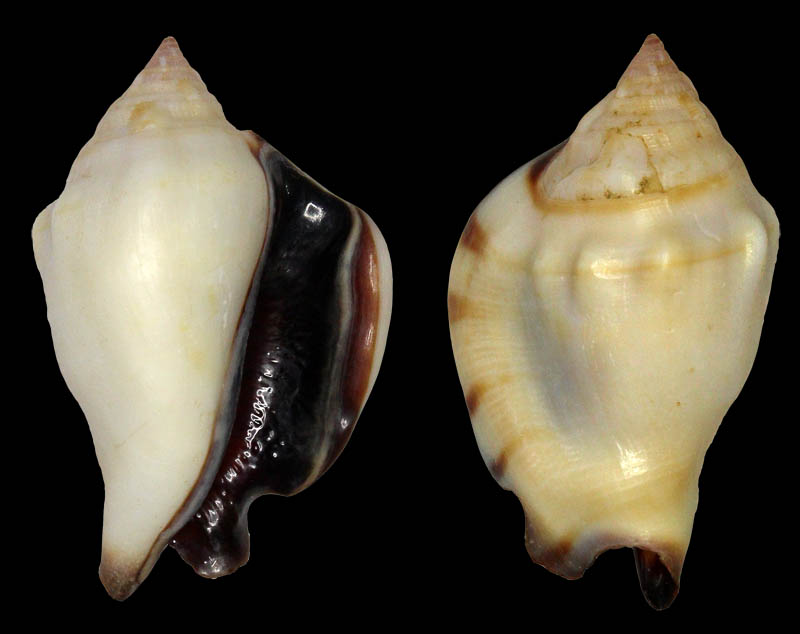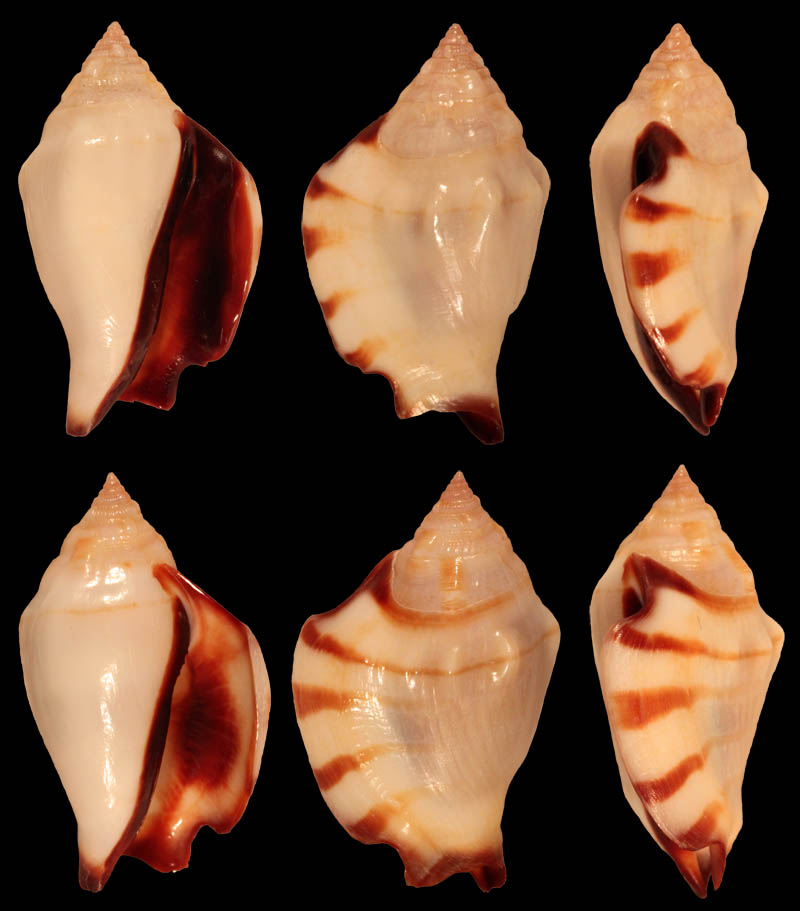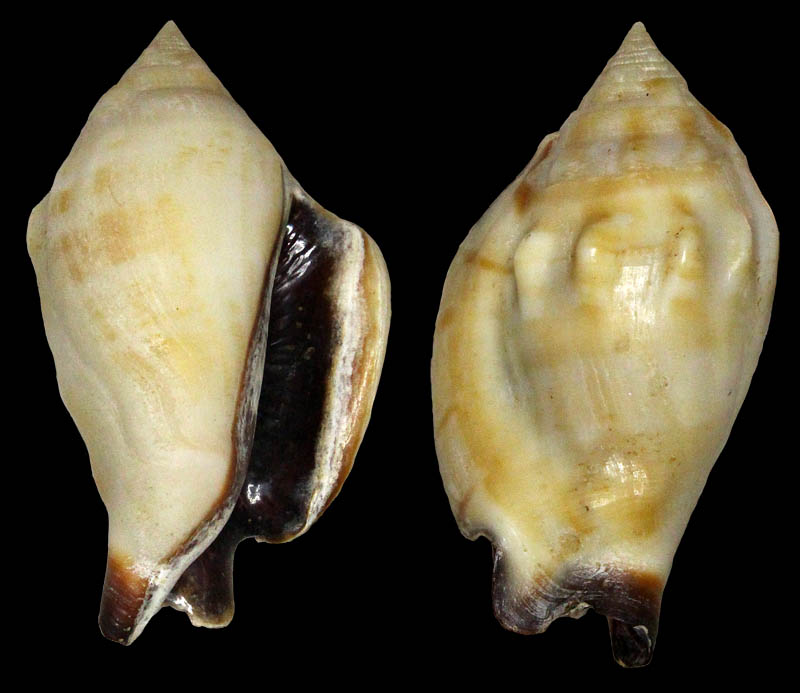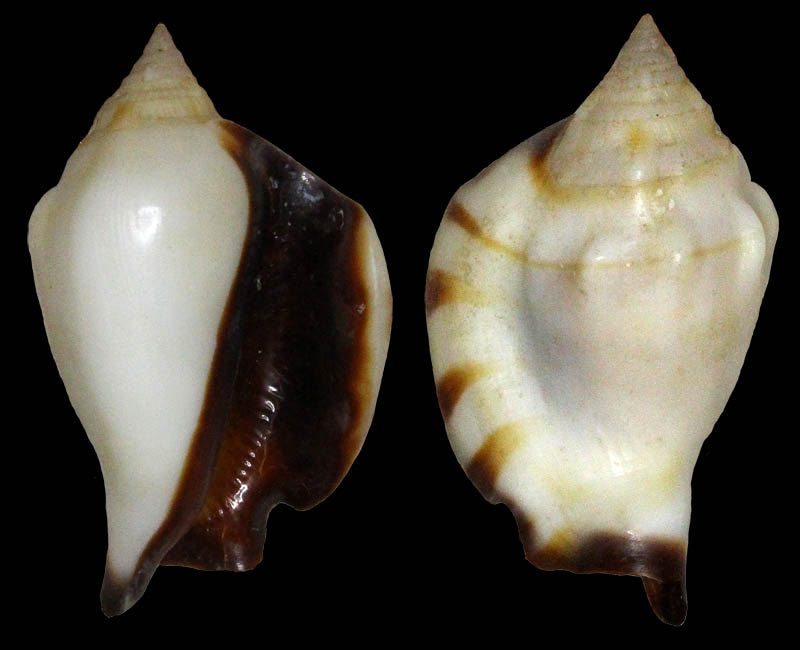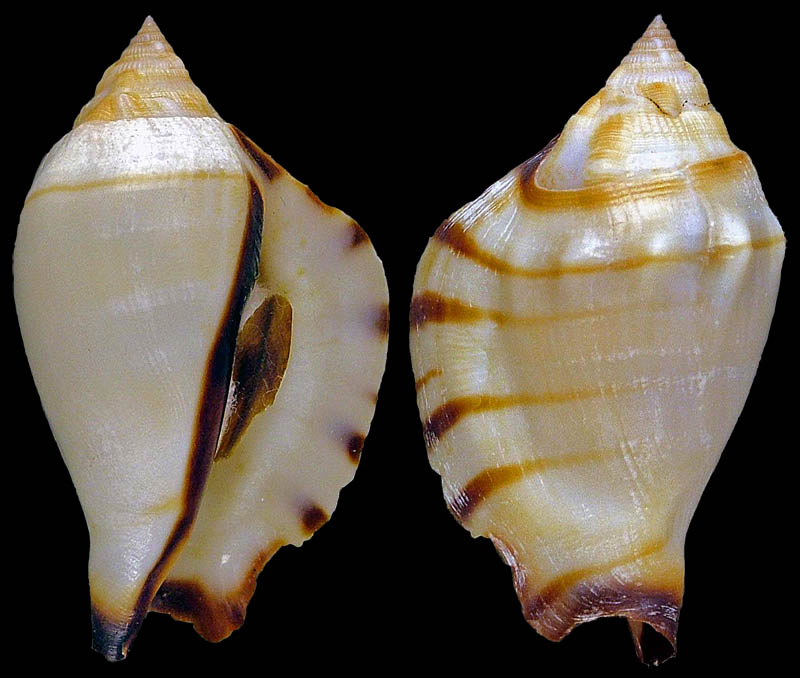Stromboidea
Original description of Strombus (Dolomena) kleckhamae by Cernohorky, 1971:
- "Shell moderate in size, 39-50 mm in length, solid and moderately heavy; spire short and slightly elevated, whorls 9 inclusive of 3 smooth and glassy nuclear whorls, whorls concave below suture. Sculptured with 13 swollen and broad varices, fine and elevated axial riblets numbering 40-45 on antepenultimate whorl and becoming obsolete on the last 2 whorls; fine spiral threads encircling whorls, 5-10 on penultimate whorl and 40-45 on body whorl; spiral threads visible only on last half of body whorl toward labial lip. Dorsal side of body whorl and occasionally penultimate whorl with 5-6 small but distinct knobs. Aperture long and flaring, commencing at antepenultimate whorl; labial lip thickened and inflected, stromboid notch and siphonal notch both prominent. Interior labial lip sculptured with 8-34 lirae, some of them bifurcate, extending almost to edge of labial lip; columella calloused and glazed, swollen anteriorly, and sculptured with 10-16 lirae on parietal wall, lower half of the columella smooth. Siphonal canal produced and recurved towards dorsum. Colour of shell cream, leaden-grey or fawn, with irregular brown stains on early whorls, a brown spiral line passing through the knobs on body whorl and 5 broad, short brown stripes on edge of labial lip; aperture, columella and tip of siphonal canal dark purple-brown."
Locus typicus: West side of Matupi Island, Simpson Harbour, Rabaul, New Britain, Territory of Papua and New Guinea; in pumice bank, 10 feet (3 metres) above sea-level.
Holotype: Auckland Institute and Museum no. TM-1326 (AK-71326); length 49.8 mm, width 30.0 mm, height of aperture 41.0 mm (leg. W. M. English, 1967); 8 obscure lirae on labial wall and 10 lirae on parietal wall
Strombus (Dolomena) kleckhamae Cernohorsky, 1971; Holotype; West side of Matupi Island, Simpson Harbour, Rabaul, New Britain, Papua New Guinea; Coll. Auckland Museum no. AK 71326; Copyright Auckland Museum
Etymology: Species is named for Mrs. Marjorie Kleckham, Port Moresby, Papua, who brought this species to the attention of Mr. Cernohorsky.
Remark: The pumice bank deposit at Matupi Island contains strata of "semifossil" molluscs, which were presumably deposited there in the course of the recent volcanic uplift during the eruption of Matupi volcano in 1937.
History and Synonymy
1977
L. Goldberg & E.G. Leehman, 1977, p. 5 & 7 tell a story of a diver Brian Bailey in the Solomons, recovering war wrecks and seashells, dredging kleckhamae in a 100 m near Florida island, Solomons. A pair of live specimens is reported, one figured.
2013
Liverani, 2013, p. 38:
- "Range: New Britain and New Ireland (Papua New Guinea) and Solomon Islands. Reported by R. Tucker Abbott as found in Geelvink Bay (Sarera Basin, Irian Jaya, Indonesia), and near Ceram (Seram, Maluku, Indonesia) by Harry Wilson. These reports need confirmation."
- "Remarks: Most specimens on the market are subfossils from Rabaul Bay, New Britain; a few live shells have recently been dredged near New Ireland, at about 100 m depth. About forty years ago a few live specimens were dredged in the Solomons."
Specimens from private collections
Barneystrombus kleckhamae (Cernohorsky, 1971); East of New Hanover Island, Bismarck Archipelago, Papua New Guinea; dredged alive at 110m on rubble; Coll. Gijs Kronenberg no. 6302
Barneystrombus kleckhamae (Cernohorsky, 1971); Goodenough Island, New Guinea; Coll. Paul Kanner
Barneystrombus kleckhamae (Cernohorsky, 1971); Matupi, Rabaul, East New Britain Province, New Britain Island, Papua New Guinea, 47,5mm; Coll. Chong Chen
- Comment Chen: "The exquisite "Kleckham's Conch", with its striking 'black mouth', is a much celebrated rarity among strombids. The dark aperture extends to the dorsal face of the anterior extremities, its intensity increases with maturity though this does also vary among individuals. In addition, the four dark lines on the dorsum is another important characteristic (though not absolutely always present); the most anterior of the four usually stretches across the entire whorl. It has a very restricted range in the Western Pacific, known only from Papua New Guinea and Solomon Islands. The holotype is a subfossil specimen taken from pumice deposits of Matupi Island near Rabaul (New Britain, Papua New Guinea) which contains many molluscs presumably deposited during the volcanic uplift in 1937, in the major eruption of Matupi volcano. In fact, vast majority of the specimens offered on the market are subfossil specimens from the Rabaul Bay; such subfossils were once only uncommon but appears to have become more scarce recently. Fresh specimens are very rare even in dead-collected condition, live-taken specimens are extremely rare. Supposedly decades ago some specimens were dredged live in the Solomon Islands, and more recently a few have also been live-taken in Papua New Guinea. Presumably a herbivorous gastropod feeding mostly on algae, the few live-taken specimens have been collected around a depth of 100~110m on rubble. Typical shell length around 45mm, very large specimens approaches 55mm. It is named in honour of Mrs. Marjorie Kleckham, Port Moresby, Papua, who first recognised that it is a new species. The closely related Barneystrombus boholensis (Mühlhäusser, 1981), mainly known from around Bohol Island in the Philippines where it is quite common, was originally described as its subspecies but is now generally considered to be a separate species in its own right. The shell of B. boholensis is larger (average around 60mm, largest specimens exceeding 75mm) and has a very different pattern on the dorsum without the black lines. Unlike B. kleckhamae the anterior extremities (especially the dorsal face, including the anterior siphonal canal) are not black in B. boholensis."
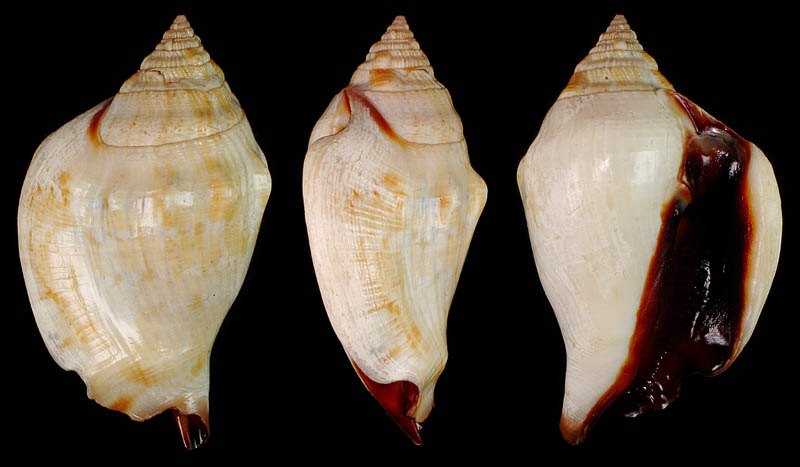
Barneystrombus kleckhamae (Cernohorsky, 1971); East New Britain Province, New Britain Island, Papua New Guinea; 01/1976; 46,5 mm; Coll. Andrea Nappo
Barneystrombus kleckhamae (Cernohorsky, 1971); Papua New Guinea; Coll. Axel Alf
Barneystrombus kleckhamae (Cernohorsky, 1971); New Britain Island, Bismarck Archipelago, Papua New Guinea; 46 mm; Coll. Francesco Giovanoli
Barneystrombus kleckhamae (Cernohorsky, 1971); Rabaul, East New Britain Province, New Britain Island, Papua New Guinea; 40,3 mm; Coll. Francesco Giovanoli
Barneystrombus kleckhamae (Cernohorsky, 1971); Rabaul, East New Britain Province, New Britain Island, Papua New Guinea; fishmarket; 45 mm; Coll. Christian Börnke
Barneystrombus kleckhamae (Cernohorsky, 1971); Rabaul, East New Britain Province, New Britain Island, Papua New Guinea; from 28 m; both 43 mm; Coll. Christian Börnke
Strombus kleckhamae kleckhamae Cernohorsky, 1971; Port Moresby, New Britain Island, Papua New Guinea; 56 mm; 1977; Coll. Koenraad De Turck
Strombus kleckhamae kleckhamae Cernohorsky, 1971; Rabaul, New Britain Island, Papua New Guinea; dredged in harbor; 1976; Coll. Koenraad De Turck
Barneystrombus kleckhamae (Cernohorsky, 1971); subadult; Rabaul, East New Britain Province, New Britain Island, Papua New Guinea; dredged live; 52 mm; Coll. Dave Rolfe
References
- R. T. Abbott and S. P. Dance (1986)
- W.O. Cernohorsky (1971)
- L. Goldberg & E.G. Leehman, 1977. From Wartime Wrecks to Rare Shells, Hawaiian Shell News, 9/1977, p. 5, Fulltext
- A. Hinton (1977 a)
- K. Kreipl, G. T. Poppe, G. T. Poppe, L. Man in't Veld and K. De Turck (1999)
- G. Kronenberg and J. Berkhout (1984)
- V. Liverani (2013). The Superfamily Stromboidea: Addenda and Corrigenda, Supplement I in Poppe, Groh & Renker, A Conchological Iconography, Harxheim, 1-54, pls 131-164.
- Mühlhäusser, 1981
- Mühlhäusser H. 1982: Strombus klekhamae boholensis n. ssp. (Gastropoda: Strombidae). La Conchiglia [The Shell] XIV (156-157)(3/4).
- A. Richards, 1984. Differences in Strombus kleckhamae; Hawaiian Shell News, 3, 13, Fulltext
- Stephens, 2009
- J. G. Walls (1980)
- R. C. Willan (2000)

